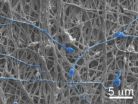(Press-News.org) SALT LAKE CITY—Huntsman Cancer Institute (HCI) researchers Michael Deininger, M.D., Ph.D., and Thomas O'Hare, Ph.D., were part of a team that found a potent oral drug, ponatinib, effective in patients who have developed resistance to standard treatments for chronic myeloid leukemia (CML) and Philadelphia chromosome positive acute lymphoblastic lymphoma (Ph+ ALL). The New England Journal of Medicine released results of the trial today.
In the phase I clinical trial conducted at five cancer centers nationwide, ponatinib was highly active in patients with CML and Ph+ ALL who had developed resistance to currently approved tyrosine kinase inhibitors (TKIs), the standard treatment for CML and Ph+ ALL. Ponatinib is a rationally developed drug, designed in the labs of study sponsor ARIAD Pharmaceuticals, Inc. to address limitations of currently available treatments. Deininger, professor and chief of Hematology and Hematologic Malignancies at Huntsman Cancer Institute at the University of Utah, and O'Hare, a research associate professor, helped to develop ponatinib, and predicted its efficacy against all known mutant forms of BCR-ABL1, the abnormal protein tyrosine kinase that causes CML.
"Ponatinib is arguably the most potent and broadest BCR-ABL1 available thus far, covering even the T315I mutant, which is completely resistant against all approved TKIs", says Deininger, a senior author on the study who leads an ongoing ponatinib trial at Huntsman Cancer Institute. "The results of this study as well as preliminary data from a larger phase 2 trial show that ponatinib has remarkable activity in patients with resistant CML and Ph+ ALL, suggesting that this new TKI will expand our therapeutic armamentarium very significantly. It is a poster child for personalized cancer therapy."
###
The study was supported by ARIAD Pharmaceuticals. Deininger and O'Hare receive support from the Huntsman Cancer Foundation and CA042014. Deininger is also a Scholar of Clinical Research of the Leukemia & Lymphoma Society.
The mission of Huntsman Cancer Institute (HCI) at the University of Utah is to understand cancer from its beginnings, to use that knowledge in the creation and improvement of cancer treatments, to relieve the suffering of cancer patients, and to provide education about cancer risk, prevention, and care. HCI is a National Cancer Institute-Designated cancer center, which means that it meets the highest national standards for cancer care and research and receives support for its scientific endeavors. HCI is also a member of the National Comprehensive Cancer Network (NCCN), a not-for-profit alliance of the world's leading cancer centers that is dedicated to improving the quality and effectiveness of care provided to patients with cancer. For more information about HCI, please visit www.huntsmancancer.org.
Clinical trial delivers good results in leukemia patients
2012-11-30
ELSE PRESS RELEASES FROM THIS DATE:
Prenatal intervention reduces learning deficit in mice
2012-11-30
Mice with a condition that serves as a laboratory model for Down syndrome perform better on memory and learning tasks as adults if they were treated before birth with neuroprotective peptides, according to researchers at the National Institutes of Health.
Down syndrome results when an individual receives an extra copy of chromosome 21. According to the Centers for Disease Control and Prevention, Down syndrome occurs in 1 of every 691 births. Features of Down syndrome include delays in mental and physical development and poor muscle tone. These features may vary greatly, ...
New radio telescope could save world billions
2012-11-30
A small pocket of Western Australia's remote outback is set to become the eye on the sky and could potentially save the world billions of dollars. The Murchison Widefield Array (MWA) radio telescope, unveiled today, Friday 30 November, will give the world a dramatically improved view of the Sun and provide early warning to prevent damage to communication satellites, electric power grids and GPS navigation systems.
The $51 million low-frequency radio telescope will be able to detect and monitor massive solar storms, such as the one that cut power to six million people ...
Intermountain Healthcare Cancer research provides possible road map for improving healthcare
2012-11-30
SALT LAKE CITY – Given the right equipment, training and skill, an individual surgeon can expect to provide the best possible care on a consistent basis. But how do you get an entire system of surgeons — each with his or her own ideas, backgrounds, and routines — to provide that same level of care?
A series of studies directed by Intermountain Healthcare's Oncology Clinical Program shows that it's possible to improve care across the board if you tackle the problem in a standardized way, relying on the best evidence available.
"It sounds simple, but it's really very ...
Grey-mouse lemurs serve as model for the early primates from which humans evolved
2012-11-30
New research shows first evidence of paternal voice recognition in solitary foraging species, provides insight into early primates from which humans evolved
Think of the last time you screamed. Chances are you attracted someone's attention. What about the last time someone flirted with you? You were likely more selective in your response.
New research findings from Arizona State University and the University of Veterinary Medicine Hannover in Germany demonstrate that a less social species – the grey-mouse lemur - pays attention to alarm calls regardless of whom they ...
Even brown dwarfs may grow rocky planets
2012-11-30
Rocky planets are thought to form through the random collision and sticking together of what are initially microscopic particles in the disc of material around a star. These tiny grains, known as cosmic dust, are similar to very fine soot or sand. However, in the outer regions around a brown dwarf -- a star-like object, but one too small to shine brightly like a star -- astronomers expected that grains could not grow because the discs were too sparse, and particles would be moving too fast to stick together after colliding. Also, prevailing theories say that any grains ...
Electrically spun fabric offers dual defense against pregnancy, HIV
2012-11-30
The only way to protect against HIV and unintended pregnancy today is the condom. It's an effective technology, but not appropriate or popular in all situations.
A University of Washington team has developed a versatile platform to simultaneously offer contraception and prevent HIV. Electrically spun cloth with nanometer-sized fibers can dissolve to release drugs, providing a platform for cheap, discrete and reversible protection.
The research was published this week in the Public Library of Science's open-access journal PLoS One. The Bill & Melinda Gates Foundation ...
When eating for 2 becomes a weighty issue
2012-11-30
Two-thirds of Australian mums-to-be are in the dark when it comes to how much weight they should gain during pregnancy.
Susie de Jersey from Queensland University of Technology's (QUT) Institute of Health and Biomedical Innovation (IHBI) and senior dietician at the Royal Brisbane and Women's Hospital said a third of women surveyed gained too much weight during pregnancy. Another third struggled to gain enough weight with some mothers recording a lower weight just before giving birth than they did before falling pregnant.
"The majority of the women in the study knew ...
The colour of love: Zebrafish perform colorful courtship displays
2012-11-30
Elaborate secondary sexual displays are often overlooked because many species attract mates through sensory modalities imperceptible to humans, including ultraviolet light, ultrasound, electrical signals, or pheromones. Also, sexual coloration may only be expressed briefly during courtship (ephemeral courtship dichromatisms) to avoid attracting predators. Zebrafish (Danio rerio) are a widely studied model organism, though there have been few studies on their mating behaviour. Like many schooling fish, zebrafish do not appear sexually dichromatic to humans; there are no ...
Help for European children to resist unhealthy temptations
2012-11-30
Children and young people in Europe are exposed to all kinds of fast food, crisps and fizzy drinks – so how can they learn to resist the temptation to indulge?
This is the question that the European research project TEMPEST was set up to answer. The research project involves researchers from nine European countries and one of the team members is Liliya Nureeva, a PhD student at Aarhus University.
The TEMPEST research project has prepared strategies for children to use to suppress or control their desire to scoff sweets and snacks. One of the main objectives of the ...
Clearest evidence yet of polar ice losses
2012-11-30
After two decades of satellite observations, an international team of experts brought together by ESA and NASA has produced the most accurate assessment of ice losses from Antarctica and Greenland to date. This study finds that the combined rate of ice sheet melting is increasing.
The new research shows that melting of the Antarctic and Greenland ice sheets has added 11.1 mm to global sea levels since 1992. This amounts to about 20% of all sea-level rise over the survey period.
About two thirds of the ice loss was from Greenland, and the remainder was from Antarctica. ...


